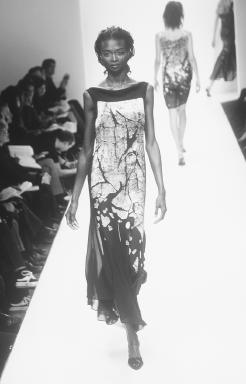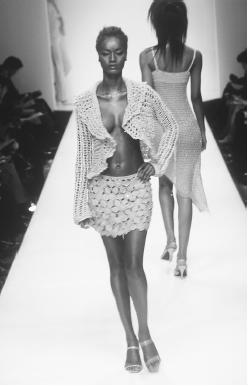Yoshiyuki Konishi - Fashion Designer Encyclopedia
Japanese knitwear designer
Born: 1950 in Tsu, Japan. Career: Established Ficce Uomo Co. Ltd. and introduced Ficce Uomo menswear line, 1981; introduced Yoshiyuki Konishi menswear line, 1987; introduced Ficce Jeans menswear line, 1988; introduced Ficce Donna womenswear line and Ficce Sport ski wear line, 1993; first New York runway show, 1997. Awards: Mainichi Fashion grand prix, 1991. Address: Ficce Uomo Co. Ltd., 4-3-11 Minami Azabu, Minato-Ku, Tokyo 106, Japan.
Publications
On KONISHI:
Books
Tokyo Collection, Tokyo, 1986.
Yoshiyuki Konishi's Knits, Tokyo, 1986.
Takeshi Beat Wears Knits of Yoshiyuki Konishi, Tokyo, 1992.

Articles
Ozzard, Janet, "New York at Bat," in WWD, 7 April 1997.
Greene, Walter, "Sexy Spring Fashions," in Black Elegance, April 1998.
*
The yarns I design are the vital essences of my finished products and the finished products are the radiators of my energy. The clothes I design—the multicolored, multitextured products—are the results of numerous experiments and challenges made and built up in the years I have lived and worked. The productions—yarn making, dyeing, knitting and weaving, and construction of the final product—all need to attain a level of equilibrium that must be maintained throughout the entire process.
In order to sustain originality, my designs begin from the productions of the single yarns and I do not believe in rationalization. Most of my handmade products require time-consuming and complicated procedures, but when artisan and spirit unite, a new world is introduced. The finished product—well-designed wearable clothes that include fantastic colors, materials, silhouettes, and shapes—function as comfortable clothes with evidence of my identity in every aspect of the product.
I hope to establish and stablize my styles and at the same time I wish to analyze the world changes and affairs and translate them into my work.
—Yoshiyuki Konishi
***
Yoshiyuki Konishi is categorized as a men's sweater designer, but his sweater is not a sweater in the conventional sense. It may be called an objet d'art, an intricate tapestry, or a Jackson Pollock painting in three dimensions, but hardly an everyday variety of sweater. Not a few people see a similarity between Konishi's sweaters and Gaudi's architecture; a Japanese critic even had Konishi's sweaters photographed in front of Gaudi's buildings in Barcelona to prove the point.
"Until I saw those photos, I hadn't known anything about Gaudi. Later I looked at Gaudi's work and realized that some of my sweaters had a lot in common with Gaudi's baroque structures," says Konishi. He wonders if Gaudi shared his creative process. "I don't plan anything. I don't leaf through art books looking for an inspiration. An idea often comes to me while I stare vacantly at an empty wall," Konishi explains. "Once I get going, more ideas spring up, and I constantly add and change even after the production process has started. My production people think I am hopelessly disorganized."
Every aspect of a Konishi sweater is unusual and excessive. An average of 30 different colors are knit into a sweater, and he has used as many as 60 colors for a particularly elaborate one. He is obsessed with the quest for new materials, even experimenting with baling ropes, leather strips, vinyl tubes, and many other odd materials and still complains, "I wish I weren't making sweaters. The requirement for comfort prohibits the use of interesting materials." His staff processes and dyes raw materials such as silk, alpaca, and angora instead of buying already processed yarns. Konishi's knitting methods are as varied as his materials: machine knit, hand crochet, macramé, to name a few. Almost every season he comes up with new stitch patterns.

Obviously, Konishi is a black sheep in the fashion industry, albeit a cheerful and genial one. He does not mind being labeled a renegade or a rebel. "Actually," he confesses, "I feel embarrassed every time people call me a fashion designer. I am not sure if what I am making is fashion." But he was peeved when a French journalist called his work un-Japanese. "This person thought that black was a 'Japanese' color," he fumed. "But black is not traditionally Japanese. Look at kimonos and obis. Japanese have always loved a riot of radiant colors."
He should know, he grew up in Japan in an old feudal castle town called Tsu, where his maternal family had operated a kimono store for generations. "My childhood memories are all about kimonos," Konishi recalls. "A trip for me meant accompanying my mother on her buying trip, to Kyoto to select gorgeous obis, or to a trade show to look at hundreds of kimono fabrics." Konishi's penchant for color was probably nurtured by early experiences, but his design motifs are anything but traditionally Japanese, including such disparate inspirations as American cartoon characters, the Amazon jungle, or mythical ancient India. You cannot stay neutral about his sweaters; you either passionately love them or passionately hate them, which is fine with Konishi. He has a sizeable following among Japan's creative and professional circles. One ardent collector of Konishi sweaters asked Konishi to design his garden. Owning dozens of Konishi sweaters was not enough for him, he wanted even his house to enjoy a touch of Konishi. As long as he has such enthusiastic supporters, Konishi would happily consume his energies in pursuit of the perfect sweater.
In spring 1997, Konishi showed for the first time in New York, after a 25-year career as a designer in Japan, where, by the end of 1996 his wholesale business totaled $30 million in sales and he had developed a wide renown, according to Women's Wear Daily. His New York show reflected his use of lavish fabrics, from knits and brocade to mohair, crochet, and velvet, as well as his attention to details. Women's Wear Daily called his knits "elaborately detailed without becoming costumey."
His Asian-inspired looks—which were noted by the U.S. press even though many Japanese observers have long felt his designs did not reflect his heritage—attracted rave reviews from critics in the U.S., who commented on his elegant use of fabric and vibrant color palette. Noting that Konishi had never received the recognition in North America he deserved, critic Walter Greene wrote in Black Elegance (April 1998): "With a clear vision of the future, this designer moves into the 21st century with style and substance."
—Yoko Hamada;
updated by Karen Raugust
Comment about this article, ask questions, or add new information about this topic: